Storing seeds is a great way to save money, and keep them as long as possible. But it’s important to do it the right way, for the best success. In this post, I’ll show you all you need to know about storing seeds for next year, or for the long-term.
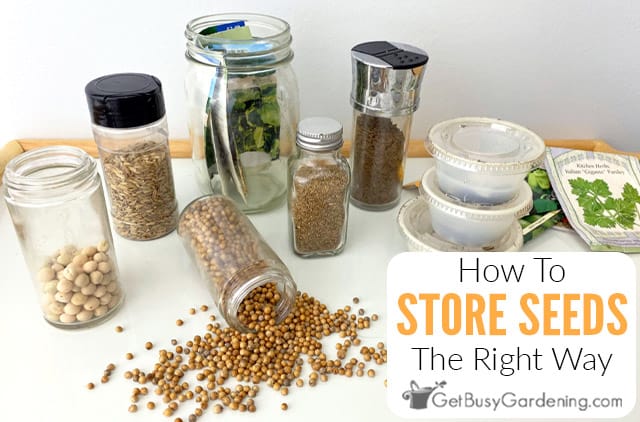
Properly storing seeds is essential, especially if you want them to last as long as possible. If done incorrectly, it’s easy for them to be destroyed by critters, moisture, or just plain old time.
Whether you have leftover purchased ones, got them from friends, or even your own garden, proper storage will keep them viable for a long time.
If you want to save your seeds for next year and beyond, there are some important steps to take to make sure they will last. Below I will show you all you need to know about properly storing seeds.
How To Store Seeds
It doesn’t matter if you have leftover seed packets from the store, or ones that you collected from your garden. You can store them to use again next year, or keep them for the long-term.
Preparing Seeds For Storage
Seeds in packets you bought at the garden center can be stored right away without any further preparation.
But, if you saved them from your garden, then you must take the proper steps to prepare them for storage.
It’s extremely important that the seeds are clean and completely dry. First, separate the seeds from the chaff (i.e.: the other bits and debris from the plant or fruit).
The larger the seed, the longer it will take to dry. This is especially true for those from the insides of meaty fruits and veggies (e.g.: squash, cucumber, tomato, etc).
Those will take much longer to dry, since they contain the most moisture. To make sure there’s not moisture left in the seeds, leave them out to air dry for at least a month.
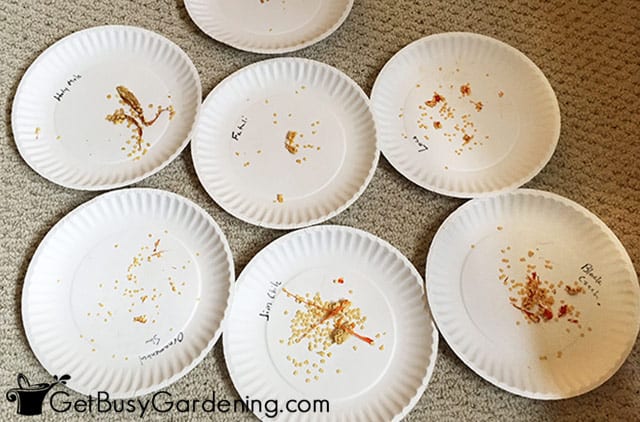
How To Choose A Seed Storage Container
Another important factor for successfully storing seeds is choosing an appropriate container to keep them in.
The good news is that there are tons of options to choose from, and there’s no need to spend a lot of money.
Properties To Look For In A Container
For the most part, it doesn’t matter what material the container is made out of. It could be plastic, glass, or paper.
However, if you choose to use plastic or glass, especially if it is airtight, then make certain the seeds are completely dry first. If they contain any moisture at all, they will likely mold.
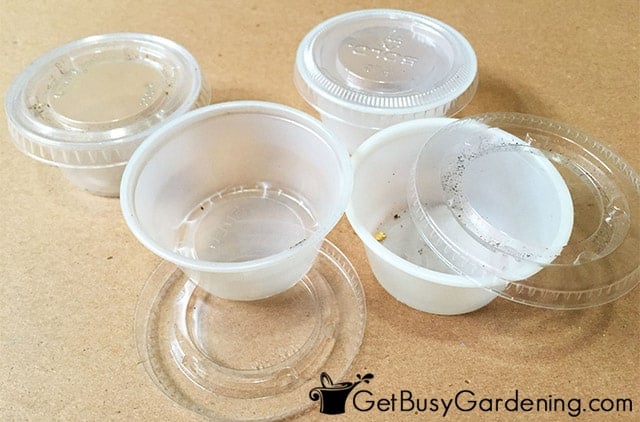
Different Types Of Containers For Storing Seeds
Like I already mentioned, there are tons of items you could use as seed storage containers.
The best part, these are all either free, or very inexpensive (and many can be reused over and over again)! Here are some ideas for you…
- Small envelopes
- Empty pill bottles
- Spice jars
- Baby food jars
- Plastic film canisters
- Envelopes from junk mail
- Zip top baggies
- Small take out containers
- Paper bags
- Empty hotel travel bottles
- Vacuum sealed bags
- DIY seed envelopes
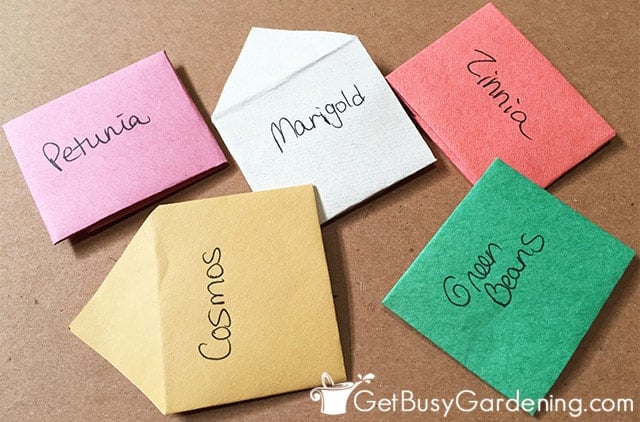
Organizing Seeds For Storage
Taking the time to organize your seed stash makes life so much easier when the busy planting season rolls around.
So, in this section, I’ll give you tips for how to organize your seeds before storing them so you can easily find what you’re looking for later on.
Label The Containers
Whatever container you decide to use for storing seeds, don’t forget to label them with the name, variety, and the date they were collected (the date on the seed packet for purchased ones).
That way, you’ll be able to keep track of how old each variety is, and make sure to either use or replenish them in a timely manner.
Tips For Organizing Your Stash
Once my seeds are all packed up in their individual containers, I put them into small plastic bins that I have labeled in alphabetical order.
If you have a bunch of leftover seeds still in their packets, you can use a cute organizer box. Otherwise, you can put them into small envelopes yourself.
My neighbor uses old photo albums with pocket sheets in them to organize her seed envelopes. Alternatively, you could put the sheets into a 3-ring binder.
Group them by type (flowers, vegetables, etc), date collected, by when they need to be planted, or put them in alphabetical order. Whatever works best for you.
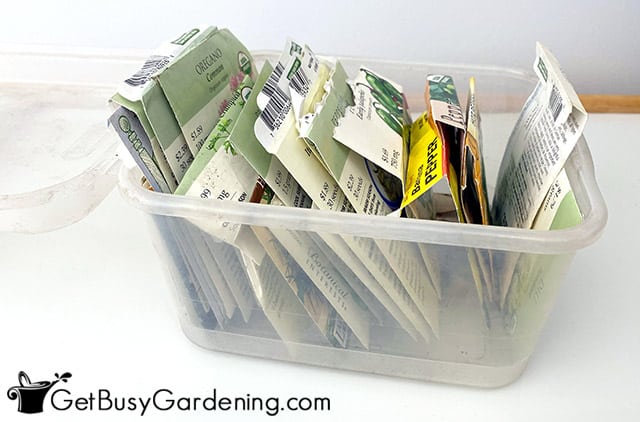
Where To Store Seeds
Once you’ve gotten everything labeled and organized, it’s time to find a place to keep them until spring.
The best place to store seeds is a dry, dark, pest-free location where the temperature remains consistently cool. I put mine in a closet in the finished basement of our home, for example.
A kitchen pantry, cupboard, or root cellar would work great too. If you don’t have a dark place to store them, then put them in an opaque container, rather than a clear one.
How Long Can You Store Seeds?
In the right conditions, many types of seeds can safely be stored for 2-6 years without significant loss of viability.
But the exact time depends on both the type of seed, and the storage conditions. The amount of time each variety will last can vary wildly.
Some seeds naturally lose their viability much faster than others, no matter what method you use to store them.
Seed Storage Times
For example, seeds of plants in the onion family, some types of edibles (carrots, garlic, parsnips, and parsley, for example), and tropical plants tend to only last one year.
On the other hand, the seeds from many types of native plants, perennial flowers, and even some vegetables and herbs can last for decades in dormancy, and still maintain their viability.
So it’s best to know how long each type of seed will last before storing it for the long term. It’s also a good idea to replenish your stash as often as you can, and toss out the oldest ones.
If you’re concerned about the age of your stored seeds, you can test the viability rate of each before you plant them. That way you won’t waste your time on the duds.
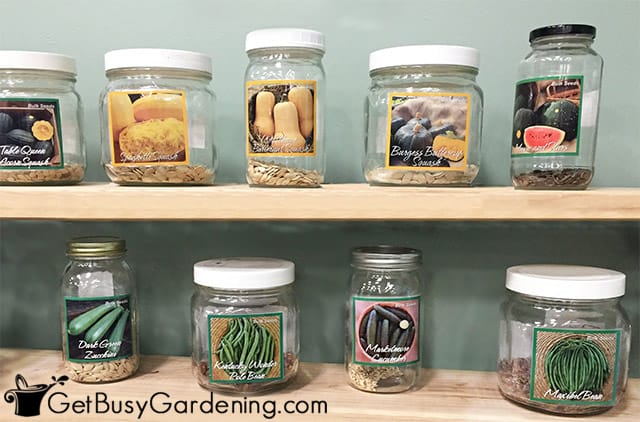
How To Store Seeds For The Long-Term Saving
If you want to keep seeds fresh for years to come, then you need to provide the most optimal conditions possible.
Moisture, temperature, light, air, and pests are the main factors that can shorten the life of stored seeds.
If you want a stash of seeds that will last for decades, then get yourself a seed vault. Otherwise, be sure to follow the tips below…
Avoid Moisture
A temperature controlled room with low humidity levels is ideal, and will make a big difference in keeping your seed stash dry too.
If humidity is a concern, then put a few silica gel packs into the container with your seeds. They will absorb excess moisture, and help to prevent rot, mold, or mildew.
Control The Temperature
Extreme temperature changes can cause condensation to build up in the container. And warm temperatures can trigger the seeds to germinate.
So, make sure to keep them out of a garage or shed, or anywhere else that the temperature can fluctuate greatly.
Reduce Exposure To Light
Exposure to light could trigger germination, or cause the inside of the container to get hot enough to essentially cook the seeds.
So be sure to keep them out of direct sunlight, and store seeds in the darkest location that you can.
If it’s too bright in your home, then simply put them into an opaque container to keep the light out.
Keep Them Airtight
Storing seeds in an airtight container will keep them dormant longer, and help extend their life. Plus it will keep moisture and pests out.
The lack of air will also kill any insects that came in with your seeds, and prevent their eggs from hatching.
So, if you want your stored seeds to last as long as possible, keep them in an airtight container.
Protect Them From Pests
Bugs and rodents can be a big problem for stored seeds, and they could ultimately destroy your stash.
So, if pests are a concern, then make sure to choose storage containers that are critter-proof.
The ones made of metal, glass, or heavy-duty plastic, and with a tight fitting lid are the best options to keep pests out.
Longer-Term Cold Storage
Another option for keeping seeds fresh for years to come is cold storage. Many gardeners store seeds in either the refrigerator or the freezer with great success.
There are some risks involved here though. Below are a few things to consider if you want to try one of these methods.
Storing Seeds In The Fridge
If you don’t have an optimal place for storing seeds in a room of your home, you could keep them in the fridge.
This is a great option, since the cooler temperature helps preserve them, and it usually stays consistent. But the concern with storing seeds in the refrigerator is moisture buildup.
The humidity level is usually pretty low inside of a fridge. But, when the door is opened a lot, it can cause moisture to form on the inside of the seed storage containers.
To reduce the risk of ruining your stash, keep them in your crisper drawer. Or better yet, put them in a refrigerator that isn’t used on a daily basis.
Storing Seeds In The Freezer
There are several types of seeds you could put into the freezer for long-term storage, which can preserve them for several years.
If you’re going to try this method, then the seeds must be completely dry. If any moisture is left in them at all, freezing could end up destroying them.
Also, it’s best to keep them in a freezer that you don’t use daily. Moisture buildup is a huge concern when freezing seeds. If they are too wet, they could be damaged by frost.
When it’s time to use the seeds, allow them to sit at room temperature for a few days before planting.
Also, once they’re thawed, don’t refreeze them. Continual freezing and thawing will greatly reduce the viability rate.
Storing seeds is quite straightforward, once you get the hang of it. Just make sure everything stays cool and dry, and your seeds could last for many years to come.
If you’re tired of struggling, and want to learn how to grow any plant you want from seed, then enroll in my online Seed Starting Course. It’s a wonderful, fun, self-paced course that will teach you everything you need to know to easily grow your own seedlings. Enroll and get started today!
Or, if you just need a refresher, then my Starting Seeds Indoors eBook is for you! It’s a quick-start guide that will get you planting seeds in no time.
Recommended Books
- The Complete Guide to Saving Seeds
- Seed Saving Techniques for Vegetable Gardeners
- Starting & Saving Seeds
- The Gardener’s Guide to Growing and Storing Vegetable and Flower Seeds
More Seed Saving Posts
- How To Harvest Butterfly Weed Seeds
- How To Get & Collect Seeds From Your Radishes
- How To Save Pea Seeds From Your Garden
- How To Collect Castor Bean Seeds
Share your favorite ways to store seeds in the comments section below.
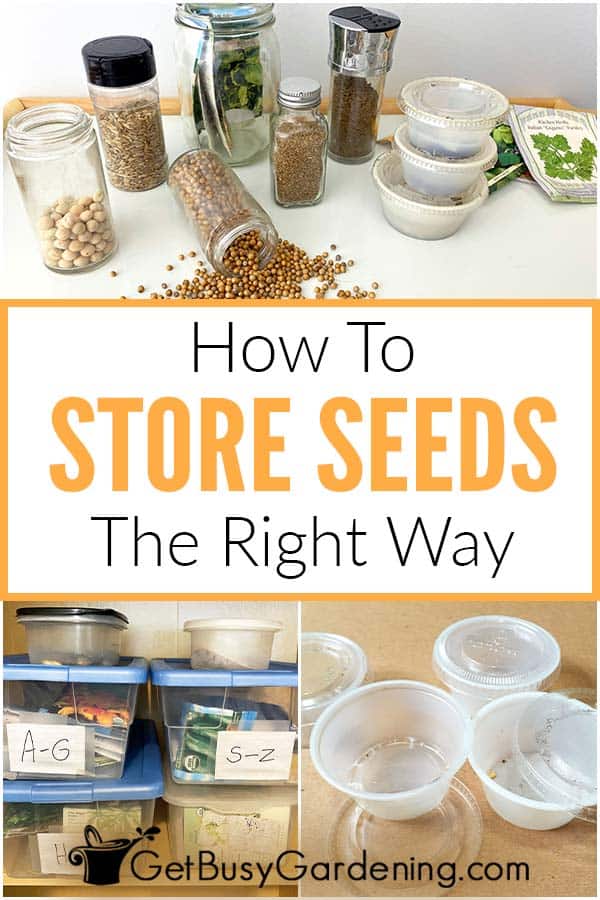
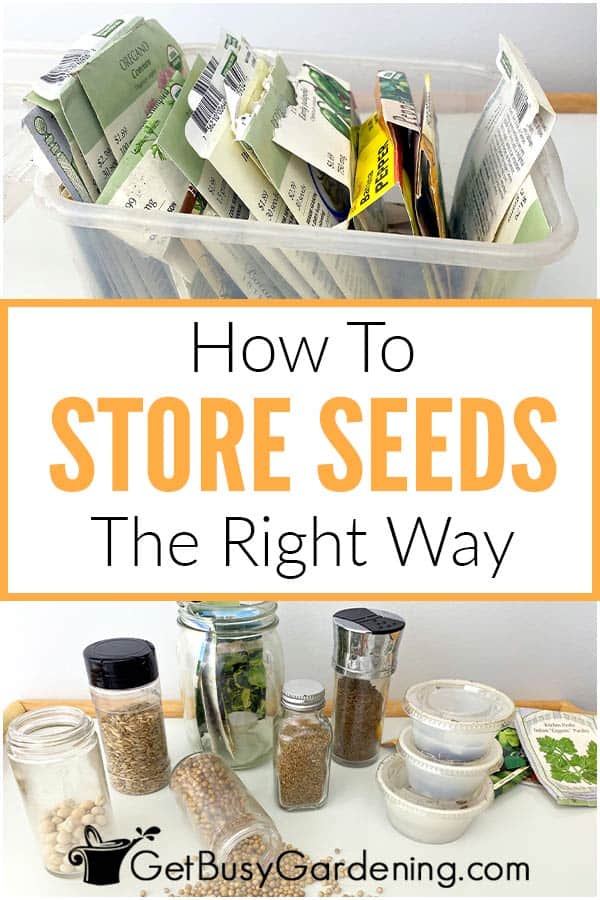
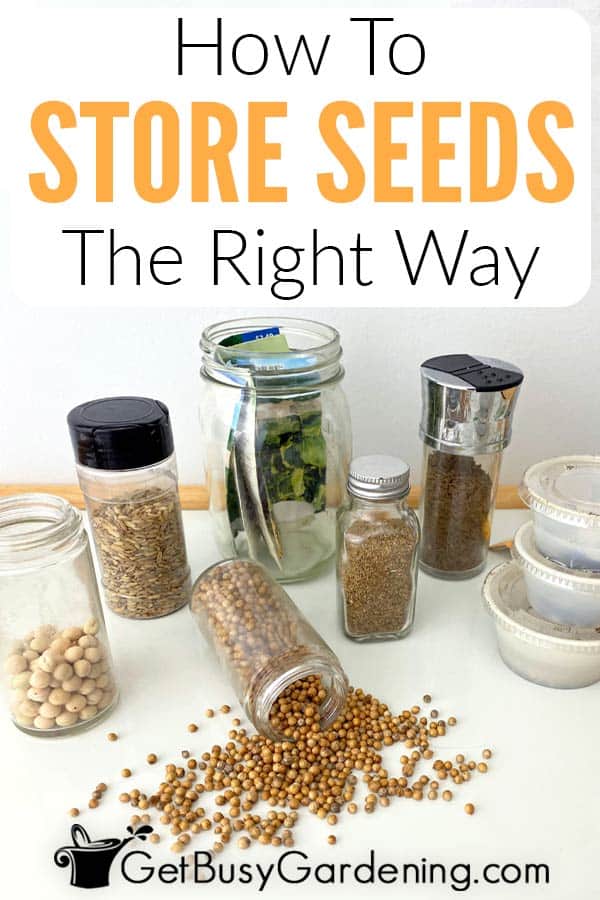

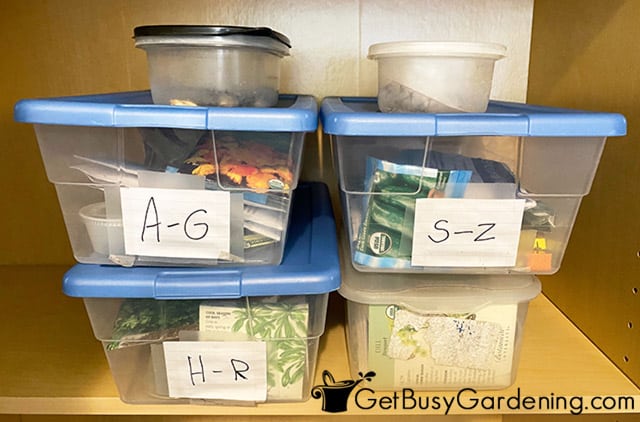
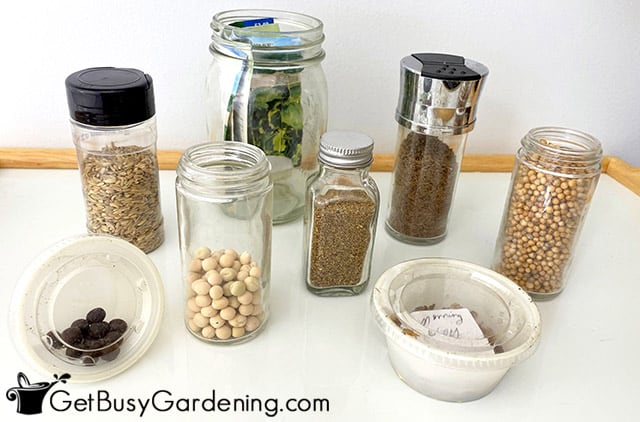


Ron Mitchell says
I like to save my beans for making chili and soups. However, when I store them in jars I sometimes get a hatching of bugs (weevil?) exiting the beans, leaving small holes. If I freeze the bean seeds for a few hours, would this kill the bugs and still be viable for planting the following spring?
Amy Andrychowicz says
Yes, as long as they are completely dry, you can freeze seeds. Putting them into airtight containers will also kill any bugs that are present. So you could try that instead of (or in addition to) freezing them.
Garden11 says
HI Amy, I also recommend seed storage in glass jars – I especially like those small ketchup and jam jars you get at hotels with room service. If you have a friend who travels a lot for business, ask them to save those for you!
Amy Andrychowicz says
That’s a great idea for seed storage containers! Thanks for sharing.
Viola Blake says
i use coffee filters to save seeds from my vegetables, then store them in plastic bowls with snap tight lids.
Amy Andrychowicz says
Awesome, thanks for sharing your method for storing your seeds! 🙂
J.L. says
I store all my seeds in tins. I place the smallest seeds in small ziplock bags. Larger seeds, larger bags… I have a labeler & I make labels for all the bags. Then I place the seeds in tins. I have one or more tins for each vegetable type. For example, I have a very large tin for all my corn seed because I have about 25-30 varieties of corn. All the dry bean seeds go in its own tin, green beans have their own tin. Dry peas have a tin, tomatoes & peppers have a tin, herbs have a tin & so on. I also label all the tins. Then I place all the tins in a large black plastic footlocker.
Tins do take up a lot more space than your system but tins are a lot more secure from insects & rodents.
Amy Andrychowicz says
Awesome, thanks for sharing how you store your seeds!!
Frank Mosher says
I save a lot of seeds, and always root a lot of cuttings. There is a real easy way to save tomato seeds. If you eat a great tomato through the winter, save the seeds by merely smearing same out on a double piece of paper towel, marking the type, the year, and if they “must” be planted in a certain year, fold it with the felt pen label on the outside. Most tomatoes from the grocery stores breed true, even if they are hybrids. In particular, the grape tomatoes, even though a hybrid, breed true all the time, as do the yellow/orange grape toms, the yellow pears, and the brown heirloom round ones, as well as most if not all of the small round reds, yellow and orange ones. They dry out very quickly in the paper towel, ready for early indoor starting in the Spring. Tomato seeds are really tough. At sewer outlets, these seeds that have gone through some ones digestive system first, are often found fruiting very near the outlet pipes. True. Fantastic dry growing season for tomatoes in Nova Scotia. Note: At this stage now, with just sooooooooooooo many, I am just firing them into the freezer without any prep work other than a quick rinse. Fantastic for making a really rich, concentrated tomato sauce, or whatever! However, the dry season was not good for beans, pole or bush/filet. Great for Peaches, Japanese and European plums, Apples. Fantastic for HT roses and HT rose Climbers. High-Bush blueberries were great despite dryness. (There is an underground brook which passes under ours). Unbelievable grape yield, and even the zucchini’s are huge. Wow! Sorry to be so loquacious, just wanted to let you know how our garden went this year. Cheers!
Amy Andrychowicz says
Awesome, thanks for sharing your tips about how you store seeds! It was a great gardening season for me too!